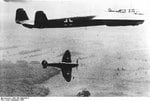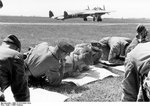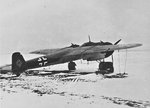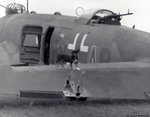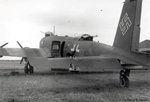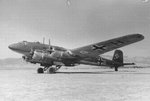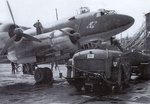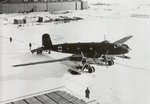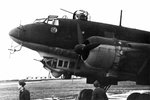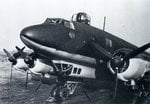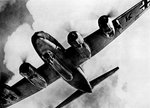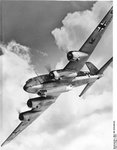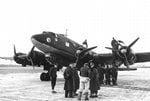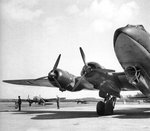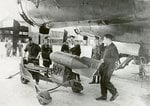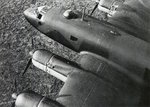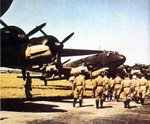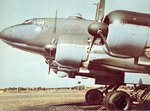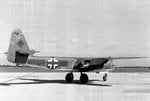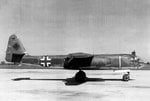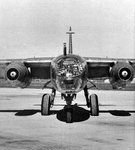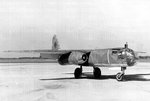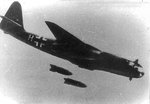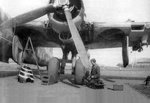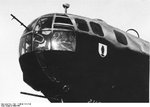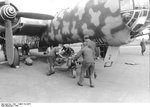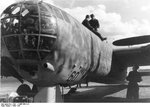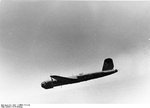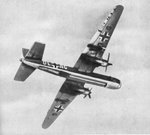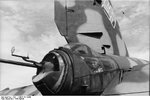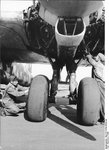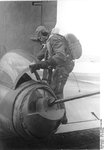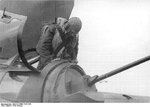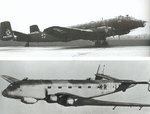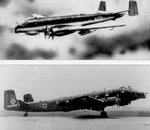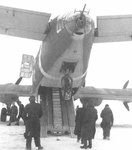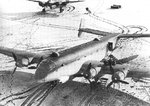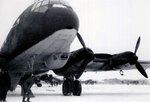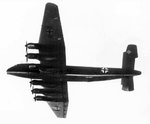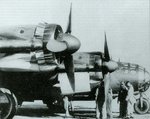- Thread starter
- #21
In late 1936, the Do 17 E-1 began to be mass produced. The first Luftwaffe units to be receive the bomber were Kampfgeschwader 153 (KG 153), and KG 155. Aufklärungsgruppe (F)/122, a reconnaissance unit, began converting to the Do 17 F-1. In early 1937, KG 255 was formed, also to be equipped with the Do 17 E-1. According to the Generalquartiermeister der Luftwaffe, 479 Do 17s were on strength. Some 100 more had been lost in crashed or sent to Spain. On 12 March 1938, Do 17Es of KG 155 dropped pro-Nazi leaflets on Vienna, as a prelude to the city's occupation during the German Anschluss operation. KG 153 received its first Do 17 E-1s on 20 September 1938 as part of a mass re-equipment program (note the significance of the date). The unit was redesignated KG 3 on 1 May 1939. KG 155 converted on to the type in early 1938. KG 252 was also equipped with the Do 17M, at this time to meet the threat of the Sudeten Crisis. By December 1938, it had 26 Do 17s and 17 crews. On 1 May 1939, the Kampfgeschwader was redesignated Kampfgeschwader 2.
Polish Campaign
A series of new models introduced the new enlarged nose, greatly increasing defensive firepower, finally settling on the Z models, which were widely available by 1939. During the first phase of World War II, the Do 17, along with the He 111, formed the backbone of the Luftwaffe's Kampfgruppen. From 1939 to 1940, four of the Luftwaffe's bomber groups, KG 2, KG 3, KG 76 and KG 77 operated the Dornier. KG 76 and KG 77 operated the first generation Do 17E, with the other two Kampfgeschwader operating only the Do 17Z on the outbreak of war. On 1 September 1939, 533 Dorniers and 705 Heinkels were combat-ready. The total strength of the Dornier force was approximately 100 Do 17 E-1s, 32 M-1s, 188 Z-1 and Z-2s as well as 213 P-1s. Its reliability and robustness made it highly popular in the Luftwaffe. During the campaign, Do 17s of I./KG 2 took part in the Battle of Bzura, in which they used incendiary bombs against Polish forces consisting of Army Poznań and Army Pomorze. These raids caused a huge number of Polish casualties, who by now had retreated to dense wooded areas, contributing to their vulnerability. The Do 17 had performed well and could use its speed to outrun Polish fighter aircraft.
Battle of France
The first German aircraft shot down over France during the war was a Dornier Do 17P of 2(F)123, brought down by Pilot Officer Mould's Hawker Hurricane of No. 1 Squadron RAF on 30 October 1939. The Dornier, Wrk Nr. 4414, constructed at Blohm Voss, crashed near Vassincourt, killing all three of its crew, Hauptmann Balduin von Norman, Oberleutnant Hermann Heisterberg and Feldwebel Friedrich Pfeuffer.
On 10 May the Dornier units, Kampfgeschwader 2, KG 3 and KG 4, were under the command of Fliegerkorps. II. Kampfgeschwader 76 and 77 also operated the Do 17 under Fliegerkorps I and Fliegerkorps VIII. The Do 17 saw its usefulness diminish during the French campaign owing to its limited bomb load and range. The design continued to be favoured by the Luftwaffe aircrews, as it was more maneuverable than the He 111 or Ju 88, and because of its ability to perform low-level strikes well. An example of this was a raid carried out by KG 2 against the RAF-controlled airfield at Vraux on 10 May. Six Bristol Blenheims and two Fairey Battles of No. 114 Squadron RAF were destroyed, with many more damaged. However Allied fighter resistance on the first day was severe, and KG 2 and KG 3 of Fliegerkorps II lost a total of 19 Do 17s between them on 10 May. Only two weeks into the campaign, KG 2 and 3 suffered fuel shortages, keeping the Dorniers grounded, and forcing some attacks to be aborted. By the beginning of June, the Dornier Geschwader were encountering less opposition and losses declined sharply, as the Armée de l'Air was no longer a sufficient threat. However, over Dunkirk, the RAF fighters inflicted a high loss rate. On 2 June, 30 German aircraft were destroyed, including 16 Do 17s (4 from KG 2 and 12 from KG 3). The Dornier units dropped some 320 tonnes (350 tons) of bombs.
Polish Campaign
A series of new models introduced the new enlarged nose, greatly increasing defensive firepower, finally settling on the Z models, which were widely available by 1939. During the first phase of World War II, the Do 17, along with the He 111, formed the backbone of the Luftwaffe's Kampfgruppen. From 1939 to 1940, four of the Luftwaffe's bomber groups, KG 2, KG 3, KG 76 and KG 77 operated the Dornier. KG 76 and KG 77 operated the first generation Do 17E, with the other two Kampfgeschwader operating only the Do 17Z on the outbreak of war. On 1 September 1939, 533 Dorniers and 705 Heinkels were combat-ready. The total strength of the Dornier force was approximately 100 Do 17 E-1s, 32 M-1s, 188 Z-1 and Z-2s as well as 213 P-1s. Its reliability and robustness made it highly popular in the Luftwaffe. During the campaign, Do 17s of I./KG 2 took part in the Battle of Bzura, in which they used incendiary bombs against Polish forces consisting of Army Poznań and Army Pomorze. These raids caused a huge number of Polish casualties, who by now had retreated to dense wooded areas, contributing to their vulnerability. The Do 17 had performed well and could use its speed to outrun Polish fighter aircraft.
Battle of France
The first German aircraft shot down over France during the war was a Dornier Do 17P of 2(F)123, brought down by Pilot Officer Mould's Hawker Hurricane of No. 1 Squadron RAF on 30 October 1939. The Dornier, Wrk Nr. 4414, constructed at Blohm Voss, crashed near Vassincourt, killing all three of its crew, Hauptmann Balduin von Norman, Oberleutnant Hermann Heisterberg and Feldwebel Friedrich Pfeuffer.
On 10 May the Dornier units, Kampfgeschwader 2, KG 3 and KG 4, were under the command of Fliegerkorps. II. Kampfgeschwader 76 and 77 also operated the Do 17 under Fliegerkorps I and Fliegerkorps VIII. The Do 17 saw its usefulness diminish during the French campaign owing to its limited bomb load and range. The design continued to be favoured by the Luftwaffe aircrews, as it was more maneuverable than the He 111 or Ju 88, and because of its ability to perform low-level strikes well. An example of this was a raid carried out by KG 2 against the RAF-controlled airfield at Vraux on 10 May. Six Bristol Blenheims and two Fairey Battles of No. 114 Squadron RAF were destroyed, with many more damaged. However Allied fighter resistance on the first day was severe, and KG 2 and KG 3 of Fliegerkorps II lost a total of 19 Do 17s between them on 10 May. Only two weeks into the campaign, KG 2 and 3 suffered fuel shortages, keeping the Dorniers grounded, and forcing some attacks to be aborted. By the beginning of June, the Dornier Geschwader were encountering less opposition and losses declined sharply, as the Armée de l'Air was no longer a sufficient threat. However, over Dunkirk, the RAF fighters inflicted a high loss rate. On 2 June, 30 German aircraft were destroyed, including 16 Do 17s (4 from KG 2 and 12 from KG 3). The Dornier units dropped some 320 tonnes (350 tons) of bombs.
Attachments
Last edited:




